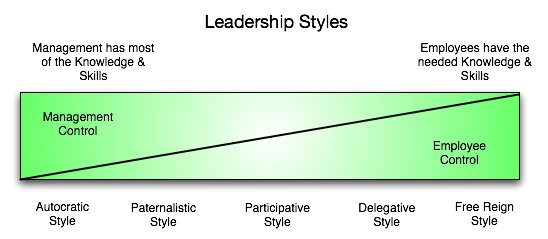- Authoritarian or autocratic
- Participative or democratic
- Delegative or Free Reign
Authoritarian (autocratic)

I want both of you to. . . This style is used when leaders tell their employees what they want done and how they want it accomplished, without getting the advice of their followers. Some of the appropriate conditions to use it is when you have all the information to solve the problem, you are short on time, and your employees are well motivated.
Some people tend to think of this style as a vehicle for yelling, using demeaning language, and leading by threats and abusing their power. This is not the authoritarian style, rather it is an abusive, unprofessional style called “bossing people around.” It has no place in a leader's repertoire.
The authoritarian style should normally only be used on rare occasions. If you have the time and want to gain more commitment and motivation from your employees, then you should use the participative style.
Participative (democratic)

Let's work together to solve this. . . This style involves the leader including one or more employees in the decision making process (determining what to do and how to do it). However, the leader maintains the final decision making authority. Using this style is not a sign of weakness, rather it is a sign of strength that your employees will respect.
This is normally used when you have part of the information, and your employees have other parts. Note that a leader is not expected to know everything — this is why you employ knowledgeable and skillful employees. Using this style is of mutual benefit — it allows them to become part of the team and allows you to make better decisions.
Delegative (free reign)

You two take care of the problem while I go. . . In this style, the leader allows the employees to make the decisions. However, the leader is still responsible for the decisions that are made. This is used when employees are able to analyze the situation and determine what needs to be done and how to do it. You cannot do everything! You must set priorities and delegate certain tasks.
This is not a style to use so that you can blame others when things go wrong, rather this is a style to be used when you fully trust and confidence in the people below you. Do not be afraid to use it, however, use it wisely!
NOTE: This is also known as laissez faire (or lais·ser faire), which is the noninterference in the affairs of others. [French : laissez, second person pl. imperative of laisser, to let, allow + faire, to do.]
Forces

- Using an authoritarian style on a new employee who is just learning the job. The leader is competent and a good coach. The employee is motivated to learn a new skill. The situation is a new environment for the employee.
- Using a participative style with a team of workers who know their job. The leader knows the problem, but does not have all the information. The employees know their jobs and want to become part of the team.
- Using a delegative style with a worker who knows more about the job than you. You cannot do everything and the employee needs to take ownership of her job! In addition, this allows you to be at other places, doing other things.
- Using all three: Telling your employees that a procedure is not working correctly and a new one must be established (authoritarian). Asking for their ideas and input on creating a new procedure (participative). Delegating tasks in order to implement the new procedure (delegative).
- How much time is available.
- Are relationships based on respect and trust or on disrespect?
- Who has the information — you, your employees, or both?
- How well your employees are trained and how well you know the task.
- Internal conflicts.
- Stress levels.
- Type of task. Is it structured, unstructured, complicated, or simple?
- Laws or established procedures such as OSHA or training plans.
Positive and Negative Approaches
There is a difference in ways leaders approach their employee. Positive leaders use rewards, such as education, independence, etc. to motivate employees. While negative employers emphasize penalties. While the negative approach has a place in a leader's repertoire of tools, it must be used carefully due to its high cost on the human spirit.Negative leaders act domineering and superior with people. They believe the only way to get things done is through penalties, such as loss of job, days off without pay, reprimanding employees in front of others, etc. They believe their authority is increased by frightening everyone into higher levels of productivity. Yet what always happens when this approach is used wrongly is that morale falls; which of course leads to lower productivity.
Also note that most leaders do not strictly use one or another, but are somewhere on a continuum ranging from extremely positive to extremely negative. People who continuously work out of the negative are bosses while those who primarily work out of the positive are considered real leaders.
Use of Consideration and Structure
Two other approaches that leaders use are:Consideration (employee orientation) — leaders are concerned about the human needs of their employees. They build teamwork, help employees with their problems, and provide psychological support.
Structure (task orientation) — leaders believe that they get results by consistently keeping people busy and urging them to produce.
There is evidence that leaders who are considerate in their leadership style are higher performers and are more satisfied with their job (Schriesheim, 1982).
Also notice that consideration and structure are independent of each other, thus they should not be viewed on opposite ends of a continuum. For example, a leader who becomes more considerate, does not necessarily mean that she has become less structured.
See Blake and Mouton's Managerial Grid as it is also based on this concept.
Paternalism
Paternalism has at times been equated with leadership styles. Yet most definitions of leadership normally state or imply that one of the actions within leadership is that of influencing. For example, the Army uses the following definition:Leadership is influencing people — by providing purpose, direction, and motivation — while operating to accomplish the mission and improving the organization.The Army further goes on by defining “influence” as:
a means of getting people to do what you want them to do. It is the means or method to achieve two ends: operating and improving. But there is more to influencing than simply passing along orders. The example you set is just as important as the words you speak. And you set an example — good or bad — with every action you take and word you utter, on or off duty. Through your words and example, you must communicate purpose, direction, and motivation.
While “paternalism” is defined as (Webster):a system under which an authority undertakes to supply needs or regulate conduct of those under its control in matters affecting them as individuals as well as in their relationships to authority and to each other.
Thus paternalism supplies needs for those under its protection or control, while leadership gets things done. The first is directed inwards, while the latter is directed outwards.Geert Hofstede (1977) studied culture within organizations. Part of his study was on the dependence relationship or Power Difference — the extent to which the less powerful members of an organization expect and accept that power is distributed unequally. Hofstede gave this story to illustrate this Power Difference:
The last revolution in Sweden disposed of King Gustav IV, whom they considered incompetent, and surprising invited Jean Baptise Bernadotte, a French general who served under Napoleon, to become their new King. He accepted and became King Charles XIV. Soon afterward he needed to address the Swedish Parliament. Wanting to be accepted, he tried to do the speech in their language. His broken language amused the Swedes so much that they roared with laughter. The Frenchman was so upset that he never tried to speak Swedish again.
Bernadotte was a victim of culture shock — never in his French upbringing and military career had he experienced subordinates who laughed at the mistakes of their superior. This story has a happy ending as he was considered very good and ruled the country as a highly respected constitutional monarch until 1844. (His descendants still occupy the Swedish throne.)Sweden differs from France in the way its society handles inequality (those in charge and the followers). To measure inequality or Power Difference, Hofstede studied three survey questions from a larger survey that both factored and carried the same weight:
- Frequency of employees being afraid to express disagreement with their managers.
- Subordinates' perception of their boss's actual decision making style (paternalistic style was one choice).
- Subordinates' preference for their boss's decision-making style (again, paternalistic style was one choice).
For example, Malaysia has the highest PDI score, being 104, while Austria has the lowest with 11. And of course, as the story above illustrates, Sweden has a relative low score of 31, while France has a PDI of 68. The USA's is 40. Note that these scores are relative, not absolute, in that relativism affirms that one culture has no absolute criteria for judging activities of another culture as “low” or “noble”.

However, when paternalistic or autocratic styles are relied upon too much and the employees are ready and/or willing to react to a more consultative type of leadership style, then it normally becomes quite damaging to the performance of the organization.
sumber : www.nwlink.com/~donclark/leader/leadstl.html
Tidak ada komentar:
Posting Komentar